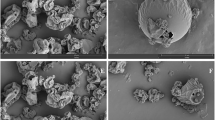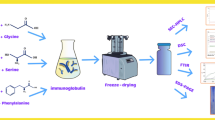Abstract
Purpose
Lyophilization and spray drying are widely used to manufacture solid forms of therapeutic proteins. Lyophilization is used to stabilize proteins vulnerable to degradation in solution, whereas spray drying is mainly used to prepare inhalation powders or as an alternative to freezing for storing bulk drug substance. Both processes impose stresses that may adversely affect protein structure, stability and bioactivity. Here, we compared lyophilization with and without controlled ice nucleation, and spray drying for their effects on the solid-state conformation and matrix interactions of a model IgG1 monoclonal antibody (mAb).
Methods
Solid-state conformation and matrix interactions of the mAb were probed using solid-state hydrogen-deuterium exchange with mass spectrometric analysis (ssHDX-MS), and solid-state Fourier transform infrared (ssFTIR) and solid-state fluorescence spectroscopies.
Results
mAb conformation and/or matrix interactions were most perturbed in mannitol-containing samples and the distribution of states was more heterogeneous in sucrose and trehalose samples that were spray dried.
Conclusions
The findings demonstrate the sensitivity of ssHDX-MS to changes weakly indicated by spectroscopic methods, and support the broader use of ssHDX-MS to probe formulation and process effects on proteins in solid samples.







Similar content being viewed by others
Abbreviations
- ATR:
-
Attenuated total reflectance
- BSA:
-
Bovine serum albumin
- CD:
-
Circular dichroism
- CN:
-
Controlled ice nucleation
- FTIR:
-
Fourier transform infrared
- HDX-MS:
-
Hydrogen deuterium exchange with mass spectrometric analysis
- IgG :
-
Immunoglobulin G
- Kfast :
-
Rate of exchange of amide hydrogen atoms in the fast exchanging pool
- Kslow :
-
Rate of exchange of amide hydrogen atoms in the slow exchanging pool
- mAb:
-
Monoclonal antibody
- Nfast :
-
Number of amide hydrogen atoms in the fast exchanging pool
- Nslow :
-
Number of amide hydrogen atoms in the slow exchanging pool
- PMT:
-
Photomultiplier tube
- PXRD:
-
Powder x-ray diffraction
- SD:
-
Spray drying
- SEM:
-
Scanning electron microscope
- ss:
-
Solid-state; indicates that an analytical method has been applied to a solid sample
- ssPL-MS :
-
Solid-state photolytic labeling with mass spectrometric analysis
- UNC:
-
Uncontrolled ice nucleation
References
Manning MC, Chou DK, Murphy BM, Payne RW, Katayama DS. Stability of protein pharmaceuticals: an update. Pharm Res. 2010;27(4):544–75.
Walters RH, Bhatnagar B, Tchessalov S, Izutsu K, Tsumoto K, Ohtake S. Next generation drying technologies for pharmaceutical applications. J Pharm Sci. 2014;103(9):2673–95.
Wang W. Lyophilization and development of solid protein pharmaceuticals. Int J Pharm. 2000;203(1–2):1–60.
Searles JA, Carpenter JF, Randolph TW. The ice nucleation temperature determines the primary drying rate of lyophilization for samples frozen on a temperature-controlled shelf. J Pharm Sci. 2001;90(7):860–71.
Geidobler R, Winter G. Controlled ice nucleation in the field of freeze-drying: fundamentals and technology review. Eur J Pharm Biopharm. 2013;85(2):214–22.
Cicerone MT, Pikal MJ, Qian KK. Stabilization of proteins in solid form. Adv Drug Deliv Rev. 2015;93:14–24.
Ohtake S, Kita Y, Arakawa T. Interactions of formulation excipients with proteins in solution and in the dried state. Adv Drug Deliv Rev. 2011;63(13):1053–73.
Awotwe-Otoo D, Agarabi C, Read EK, Lute S, Brorson KA, Khan MA. Product and process understanding to relate the effect of freezing method on glycation and aggregation of lyophilized monoclonal antibody formulations. Int J Pharm. 2015;490(1–2):341–50.
Parker A, Rigby-Singleton S, Perkins M, Bates D, Le Roux D, Roberts CJ, et al. Determination of the influence of primary drying rates on the microscale structural attributes and physicochemical properties of protein containing lyophilized products. J Pharm Sci. 2010;99(11):4616–29.
Abdul-Fattah AM, Truong-Le V, Yee L, Nguyen L, Kalonia DS, Cicerone MT, et al. Drying-induced variations in physico-chemical properties of amorphous pharmaceuticals and their impact on stability (I): stability of a monoclonal antibody. J Pharm Sci. 2007;96(8):1983–2008.
Sane SU, Wong R, Hsu CC. Raman spectroscopic characterization of drying-induced structural changes in a therapeutic antibody: correlating structural changes with long-term stability. J Pharm Sci. 2004;93(4):1005–18.
Iyer LK, Sacha GA, Moorthy BS, Nail SL, Topp EM. Process and formulation effects on protein structure in lyophilized solids using mass spectrometric methods. J Pharm Sci. 2016;105(5):1684–92.
Moorthy BS, Iyer LK, Topp EM. Mass spectrometric approaches to study protein structure and interactions in lyophilized powders. J Vis Exp. 2015(98).
Moorthy BS, Zarraga IE, Kumar L, Walters BT, Goldbach P, Topp EM, Allmendinger A. Solid-state hydrogen–deuterium exchange mass spectrometry: correlation of deuterium uptake and long-term stability of lyophilized monoclonal antibody formulations. Mol Pharm. 2017. https://doi.org/10.1021/acs.molpharmaceut.7b00504.
Sophocleous AM, Zhang J, Topp EM. Localized hydration in lyophilized myoglobin by hydrogen-deuterium exchange mass spectrometry. 1. Exchange mapping. Mol Pharm. 2012;9(4):718–26.
Fu F, DeOliveria D, Trumble W, Sakar B, Singh B. Secondary structure estimation of proteins using the amide III region of Frourier transform infrared spectroscopy. Application to analyse calcium binding-induced structural changes in calsequestrin. Appl Spectrosc. 1994;48:1432–41.
Kelly SM, Jess TJ, Price NC. How to study proteins by circular dichroism. Biochim Biophys Acta. 2005;1751(2):119–39.
Sharma VK, Kalonia DS. Steady-state tryptophan fluorescence spectroscopy study to probe tertiary structure of proteins in solid powders. J Pharm Sci. 2003;92(4):890–9.
Ramachander R, Jiang Y, Li C, Eris T, Young M, Dimitrova M, et al. Solid state fluorescence of lyophilized proteins. Anal Biochem. 2008;376(2):173–82.
Schule S, Friess W, Bechtold-Peters K, Garidel P. Conformational analysis of protein secondary structure during spray-drying of antibody/mannitol formulations. Eur J Pharm Biopharm. 2007;65(1):1–9.
Chang L, Shepherd D, Sun J, Ouellette D, Grant KL, Tang XC, et al. Mechanism of protein stabilization by sugars during freeze-drying and storage: native structure preservation, specific interaction, and/or immobilization in a glassy matrix? J Pharm Sci. 2005;94(7):1427–44.
Park J, Nagapudi K, Vergara C, Ramachander R, Laurence JS, Krishnan S. Effect of pH and excipients on structure, dynamics, and long-term stability of a model IgG1 monoclonal antibody upon freeze-drying. Pharm Res. 2013;30(4):968–84.
Souillac PO, Middaugh CR, Rytting JH. Investigation of protein/carbohydrate interactions in the dried state. 2. Diffuse reflectance FTIR studies. Int J Pharm. 2002;235(1–2):207–18.
Englander SW, Mayne L, Bai Y, Sosnick TR. Hydrogen exchange: the modern legacy of Linderstrøm-Lang. Protein Sci Publ Protein Soc. 1997;6(5):1101–9.
Li Y, Williams TD, Schowen RL, Topp EM. Characterizing protein structure in amorphous solids using hydrogen/deuterium exchange with mass spectrometry. Anal Biochem. 2007;366(1):18–28.
Moorthy BS, Schultz SG, Kim SG, Topp EM. Predicting protein aggregation during storage in lyophilized solids using solid state amide hydrogen/deuterium exchange with mass spectrometric analysis (ssHDX-MS). Mol Pharm. 2014;11(6):1869–79.
Sophocleous AM, Topp EM. Localized hydration in lyophilized myoglobin by hydrogen-deuterium exchange mass spectrometry. 2. Exchange kinetics. Mol Pharm. 2012;9(4):727–33.
Weis DD, Wales TE, Engen JR, Hotchko M, Ten Eyck LF. Identification and characterization of EX1 kinetics in H/D exchange mass spectrometry by peak width analysis. J Am Soc Mass Spectrom. 2006;17(11):1498–509.
Hsu CC, Nguyen HM, Yeung DA, Brooks DA, Koe GS, Bewley TA, et al. Surface denaturation at solid-void interface--a possible pathway by which opalescent particulates form during the storage of lyophilized tissue-type plasminogen activator at high temperatures. Pharm Res. 1995;12(1):69–77.
Koshari SH, Ross JL, Nayak PK, Zarraga IE, Rajagopal K, Wagner NJ, et al. Characterization of protein-excipient microheterogeneity in biopharmaceutical solid-state formulations by confocal fluorescence microscopy. Mol Pharm. 2017;14(2):546–53.
ACKNOWLEDGMENTS AND DISCLOSURES
The IgG1 mAb used in this study was provided by Pfizer, Inc. (Chesterfield, MO). This work was supported in part by a Purdue Research foundation grant and a McKeehan Graduate Fellowship awarded by Purdue University to EM.
Author information
Authors and Affiliations
Corresponding author
Additional information
Guest Editors: Tony Zhou and Tonglei Li
Electronic supplementary material
ESM 1
(DOCX 1005 kb)
Rights and permissions
About this article
Cite this article
Moussa, E.M., Wilson, N.E., Zhou, Q.T. et al. Effects of Drying Process on an IgG1 Monoclonal Antibody Using Solid-State Hydrogen Deuterium Exchange with Mass Spectrometric Analysis (ssHDX-MS). Pharm Res 35, 12 (2018). https://doi.org/10.1007/s11095-017-2318-9
Received:
Accepted:
Published:
DOI: https://doi.org/10.1007/s11095-017-2318-9




